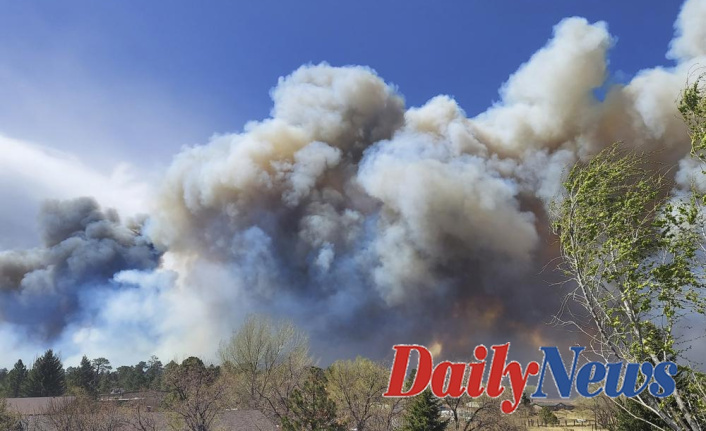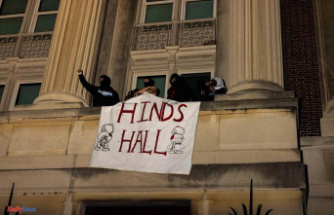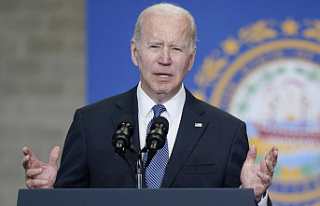As wind gusts of up 50 mph (80 km/h) drove the flames over major roads, flames rose to 100 feet (30m) through a patch of scattered homes, dry lawn and Ponderosa Pine trees in Flagstaff.
Officials from Coconino County stated that 766 homes had been evacuated and that 1,000 animals were safe. The area is popular with hikers, off-road vehicle drivers, and astronauts who have trained in volcanic cinder pits was home to about 250 structures.
After the wildfire grew from 100 acres (40 ha) Tuesday morning to more than 9 square miles (23 km2) by evening, the county declared an emergency. Ash fell from the sky and the county declared an emergency. According to Brady Smith, a Coconino National Forest spokesperson, the fire was moving northeast from Flagstaff, where Northern Arizona University is located, and towards Sunset Crater Volcano National Monument.
Smith stated that the fire is headed towards less fuel and isn't heading toward densely populated areas. "But it depends on the intensity of fire, fire can still move through cinders.
The wildfire is still burning, so authorities won't know if anyone was hurt until it has subsided. Coconino County Sheriff Jim Driscoll said that while law enforcement and firefighters went door-to-door urging people to evacuate, they had to stop to avoid being boxed in.
His office received a call from a man trapped in his home, but firefighters were unable to reach him.
Driscoll stated that "we don't know whether he made it out"
Numerous organizations set up shelters to accommodate evacuees, as well as animals, such as goats and horses.
Residents were able to recall running for their lives when the wildfires in the area were much more severe.
Kathy Vollmer, a resident, said, "This time was different. Right there in your backyard."
She claimed that her husband and she grabbed their three dogs, but she left behind a few cats as they faced "walls of fire."
She said, "We just hope that they will be OK."
The wildfire earlier in the day shut down U.S. 89 between Flagstaff, far northern Arizona and communities on Navajo Nation. High winds grounded any aircraft that could drop water or fire retardant on the blaze.
Arizona Public Service Co. is the largest utility in Arizona. It shut off power to 625 customers to protect firefighters, a spokeswoman stated.
Around 200 firefighters battled the flames. But, more will be needed as a high-ranking national management team takes control later in the week.
Sunday afternoon, the fire broke out about 14 miles (22 km) northeast Flagstaff. Investigators are still trying to determine the cause of the fire and are yet to contain it.
Ali Taranto, who works at a hospital in Winslow on Tuesday, rushed to Flagstaff to inspect a property that had been threatened by wildfires. She was also receiving messages from her neighbor to check on her. She discovered that the neighbor didn't have oxygen and couldn't open her garage to evacuate.
Taranto stated that the neighbor was "disoriented, gasping for air" upon reaching her. She said that firefighters in the area opened the garage door and brought the neighbor to the hospital. Taranto was searching for shelter for her two dogs.
Taranto had already left the area when the highway to Flagstaff was closed and she was forced to travel an additional two hours home. She said that at least two other neighbors did not evacuate.
Taranto stated, "Seeing flames a few yards from your property line was surreal. It was also very surreal to hear the propane tanks bursting in background." "Ash falling down. It was insane.
According to the National Weather Service, wind and high humidity are expected to pose a problem for the remainder of the week.
Robert Rickey, meteorologist, stated that "I don’t see any significant drops in wind, I don’t see any big ups in humidity, and we’re not really expecting any precipitation at this point."
On Tuesday, red flag warnings were posted across much of Arizona and New Mexico. This was a sign that wildfire danger is imminent. Residents of northern New Mexico's Mora, San Miguel and Santa Cruz counties were advised to prepare for evacuation as wildfires erupted in dry, warm, and windy conditions.
The National Interagency Fire Center reported Tuesday, that more than 2,000 wildland firefighters were and are assigned to fight large wildfires in the Southwestern and Southern Rocky Mountain regions. Scientists believe that climate change has made America's West warmer and dryer over the past 30 years. This will make it more extreme and more likely for wildfires to become more destructive.
Firefighters battled a wildfire in Arizona's Prescott National Forest, about 10 miles (16 km) south of Prescott.
Cory Carlson of Prescott National Forest was the incident commander. He said that the highest winds were the greatest challenge. They sent embers into high altitude, which in turn caused new spot fires to be started near State Route 261.
He said, "We do not have the resources we need." "There are many fires in this region."
Yavapai College set up a shelter for those affected areas. Carlson asked residents to follow evacuation orders.
Investigators are currently investigating the cause of the wildfire that scorched 600 acres (2.4-kilometer)
After being closed for eight hours by a brush fire in the hills above Bisbee, a major highway linking southern Arizona with Sierra Vista was reopened Tuesday.












